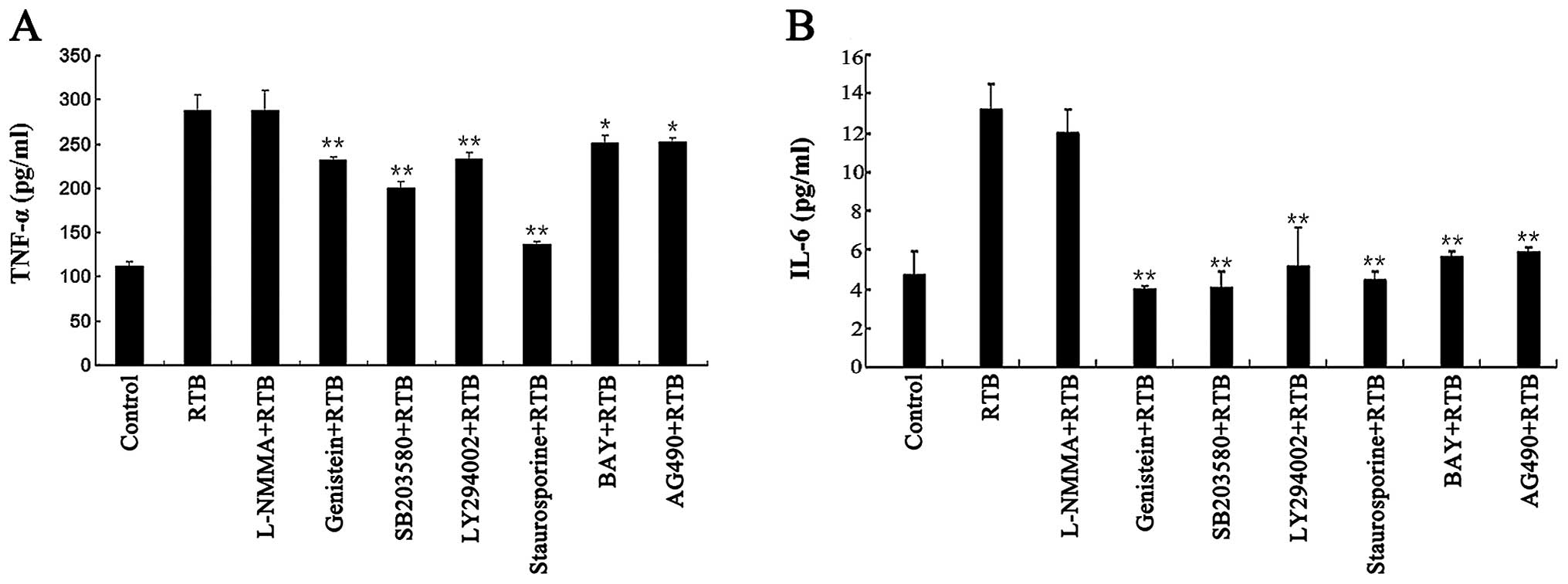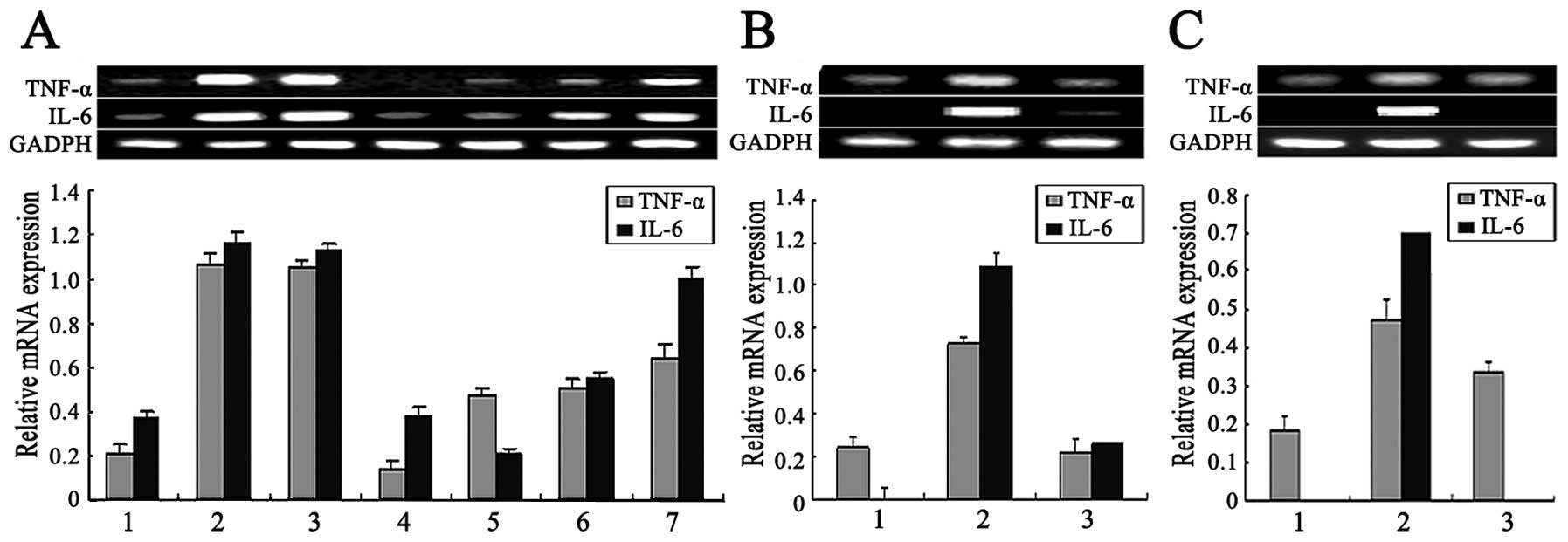|
1
|
Falnes P and Sandvig K: Penetration of
protein toxins into cells. Curr Opin Cell Biol. 12:407–413. 2000.
View Article : Google Scholar
|
|
2
|
Stirpe F and Barbieri L:
Ribosome-inactivating proteins up to date. FEBS Lett. 195:1–8.
1986. View Article : Google Scholar : PubMed/NCBI
|
|
3
|
Audi J, Belson M, Patel M, Schier J and
Osterloh J: Ricin poisoning a comprehensive review. JAMA.
294:2342–2351. 2005. View Article : Google Scholar : PubMed/NCBI
|
|
4
|
Tran H, Leong C, Loke WK, Dogovski C and
Liu CQ: Surface plasmon resonance detection of ricin and
horticultural ricin variants in environmental samples. Toxicon.
52:582–588. 2008. View Article : Google Scholar : PubMed/NCBI
|
|
5
|
Rapak A, Falnes PO and Olsnes S:
Retrograde transport of mutant ricin to the endoplasmic reticulum
with subsequent translocation to cytosol. Proc Natl Acad Sci USA.
94:3783–3788. 1997. View Article : Google Scholar : PubMed/NCBI
|
|
6
|
Sandvig K and van Deurs B: Delivery into
cells: lessons learned from plant and bacterial toxins. Gene Ther.
12:865–872. 2005. View Article : Google Scholar : PubMed/NCBI
|
|
7
|
Choi NW, Estes MK and Langridge WH:
Mucosal immunization with a ricin toxin B subunit-rotavirus NSP4
fusion protein stimulates a Th1. J Biotechnol. 121:272–283. 2006.
View Article : Google Scholar : PubMed/NCBI
|
|
8
|
Medina-Bolivar F, Wright R, Funk V, Sentz
D, Barroso L, Wilkins TD, Petri W Jr and Cramer CL: A non-toxic
lectin for antigen delivery of plant-based mucosal vaccines.
Vaccine. 21:997–1005. 2003. View Article : Google Scholar : PubMed/NCBI
|
|
9
|
Adams DO and Nathan CF: Molecular
mechanisms in tumor-cell killing by activated macrophages. Immunol
Today. 4:166–177. 1983. View Article : Google Scholar : PubMed/NCBI
|
|
10
|
Hamilton TA, Ohmori Y, Lebo JM and Kishore
R: Regulation of macrophage gene expression by pro- and
anti-inflammatory cytokines. Pathobiology. 67:241–244. 1999.
View Article : Google Scholar : PubMed/NCBI
|
|
11
|
Schorey JS and Cooper AM: Macrophage
signalling upon mycobacterial infection the MAP kinases lead the
way. Cell Microbiol. 5:133–142. 2003. View Article : Google Scholar : PubMed/NCBI
|
|
12
|
Gordon S: Pattern recognition receptors:
doubling up for the innate immune response. Cell. 111:927–930.
2002. View Article : Google Scholar : PubMed/NCBI
|
|
13
|
Bolander FF Jr: The role of nitric oxide
in the biological activity of prolactin in the mouse mammary gland.
Mol Cell Endocrinol. 174:91–98. 2001. View Article : Google Scholar : PubMed/NCBI
|
|
14
|
Kozlowska K, Cichorek M, Wachulska M and
Bautembach I: Role of interleukins and nitric oxide secretion by
peritoneal macrophages in differential tumoricidal effect to
transplantable melanomas as regarding their biological properties.
Immunopharmacol Immunotoxicol. 28:305–317. 2006. View Article : Google Scholar
|
|
15
|
Michel T and Feron O: Nitric oxide
synthases: which, where, how, and why? J Clin Invest.
100:2146–2152. 1997. View Article : Google Scholar : PubMed/NCBI
|
|
16
|
Mayer B and Hemmens B: Biosynthesis and
action of nitric oxide in mammalian cells. Trends Biochem Sci.
22:477–481. 1997. View Article : Google Scholar : PubMed/NCBI
|
|
17
|
Korhonen R, Lahti A, Kankaanranta H and
Moilanen E: Nitric oxide production and signaling in inflammation.
Curr Drug Targets Inflamm Allergy. 4:471–479. 2005. View Article : Google Scholar : PubMed/NCBI
|
|
18
|
Kolb H and Kolb-Bachofen V: Nitric oxide
in autoimmune disease: cytotoxic or regulatory mediator? Immunol
Today. 19:556–561. 1998. View Article : Google Scholar : PubMed/NCBI
|
|
19
|
Gräslund S, Eklund M, Falk R, Uhlén M,
Nygren PÅ and Ståhl S: A novel affinity gene fusion system allowing
protein A-based recovery of non-immunoglobulin gene products. J
Biotechnol. 99:41–50. 2002.PubMed/NCBI
|
|
20
|
Olsnes S and Pihl A: Different biological
properties of the two constituent peptide chains of ricin, a toxic
protein inhibiting protein synthesis. Biochemistry. 12:3121–3126.
1973. View Article : Google Scholar
|
|
21
|
Sharma S, Podder SK and Karande AA:
Comparative studies on kinetics of inhibition of protein synthesis
in intact cells by ricin and a conjugate of ricin B-chain with
momordin. Mol Cell Biochem. 200:133–141. 1999. View Article : Google Scholar : PubMed/NCBI
|
|
22
|
Robinson MJ and Cobb MH: Mitogen-activated
protein kinase pathways. Curr Opin Cell Biol. 9:180–186. 1997.
View Article : Google Scholar : PubMed/NCBI
|
|
23
|
Lim S, Kang KW, Park SY, Kim SI, Choi YS,
Kim ND, Lee KU, Lee HK and Pak YK: Inhibition of
lipopolysaccharide-induced inducible nitric oxide synthase
expression by a novel compound, mercaptopyrazine, through
suppression of nuclear factor-kappaB binding to DNA. Biochem
Pharmacol. 68:719–728. 2004. View Article : Google Scholar
|
|
24
|
Juang SH, Xie K, Xu L, Shi Q, Wang Y,
Yoneda J and Fidler IJ: Suppression of tumorigenicity and
metastasis of human renal carcinoma cells by infection with
retroviral vectors harboring the murine inducible nitric oxide
synthase gene. Hum Gene Ther. 9:845–854. 1998. View Article : Google Scholar : PubMed/NCBI
|
|
25
|
Pan D, Bera AK, Das S, Bandyopadhyay S,
Rana T, Bandyopadhyay S, Das SK and Bhattacharya D: Use of zinc
chloride as alternative stimulant for in vitro study of nitric
oxideproduction pathway in avian splenocyte culture. Mol Biol Rep.
37:2223–2226. 2010. View Article : Google Scholar : PubMed/NCBI
|
|
26
|
Dong Z, Qi X, Xie K and Fidler IJ: Protein
tyrosine kinase inhibitors decrease induction of nitric oxide
synthase activity in lipopolysaccharide-responsive and
lipopolysaccharide-nonresponsive murine macrophages. J Immunol.
151:2717–2724. 1993.
|
|
27
|
Shishodia S, Shrivastava A and Sodhi A:
Protein kinase C: a potential pathway of macrophage activation with
cisplatin. Immunol Lett. 61:179–186. 1998. View Article : Google Scholar : PubMed/NCBI
|
|
28
|
Lewis TS, Shapiro PS and Ahn NG: Signal
transduction through MAP kinase cascades. Adv Cancer Res.
74:49–139. 1998. View Article : Google Scholar : PubMed/NCBI
|
|
29
|
Angel P and Karin M: The role of Jun, Fos
and AP-1 complex in the cell-proliferation and transformation.
Biochem Biophys Acta. 1072:129–157. 1991.PubMed/NCBI
|
|
30
|
Chen CC and Wang JK: P38 but not p44/42
mitogen-activated protein kinase is required for nitric oxide
synthase induction mediated by lipopolysaccharide in RAW264.7
macrophages. Mol Pharmacol. 55:481–488. 1999.PubMed/NCBI
|
|
31
|
Yoon YD, Kang JS, Han SB, Park SK, Lee HS
and Kim HM: Activation of mitogen-activated protein kinases and
AP-1 by polysaccharide isolated from the radix of Platycodon
grandiflorum in RAW264.7 cells. Int Immunopharmacol.
4:1477–1487. 2004. View Article : Google Scholar : PubMed/NCBI
|
|
32
|
Mendes AF, Carvalho AP, Caramona MM and
Lopes MC: Role of nitric oxide in the activation of NF-kappaB, AP-1
and NOS II expression in articular chondrocytes. Inflamm Res.
51:369–375. 2002. View Article : Google Scholar : PubMed/NCBI
|
|
33
|
Connelly L, Palacios-Callender M, Ameixa
C, Moncada S and Hobbs AJ: Biphasic regulation of NF-kappa B
activity underlies the pro- and anti-inflammatory actions of nitric
oxide. J Immunol. 166:3873–3881. 2001. View Article : Google Scholar : PubMed/NCBI
|
|
34
|
Eason SW and Martin W: Involvement of
tyrosine kinase and protein kinase C in the induction of nitric
oxide synthase by LPS and IFN-γ in J774 macrophages. Arch Int
Pharmacodyn Ther. 330:225–236. 1995.
|
|
35
|
Foulkes JG, Chow M, Gorka C, Frackelton AR
Jr and Baltimore D: Purification and characterization of a protein
tyrosine kinase encoded by the Abelson murine leukemia virus. J
Biol Chem. 260:8070–8077. 1985.PubMed/NCBI
|
















